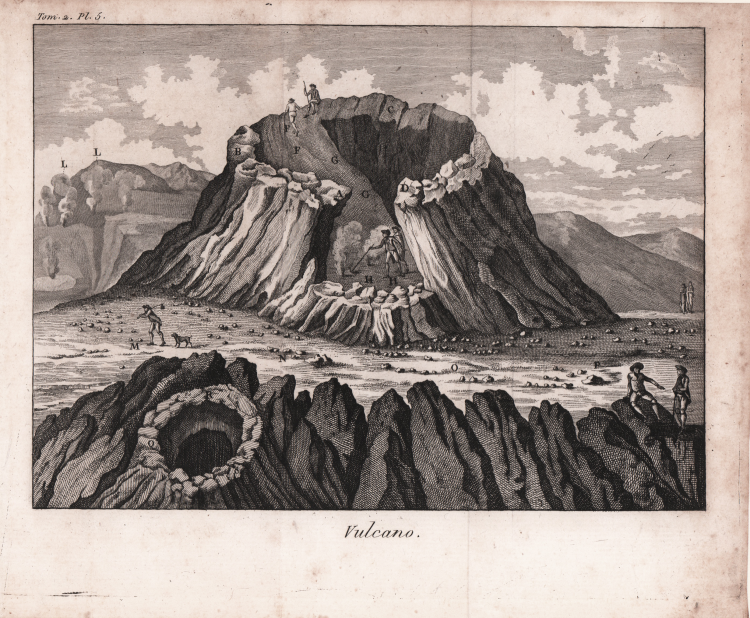



| Reference: | S46527 |
| Author | Lazzaro SPALLANZANI |
| Year: | 1799 |
| Zone: | Vulcano |
| Printed: | Paris |
| Measures: | 220 x 170 mm |


| Reference: | S46527 |
| Author | Lazzaro SPALLANZANI |
| Year: | 1799 |
| Zone: | Vulcano |
| Printed: | Paris |
| Measures: | 220 x 170 mm |
View taken from Voyages Dans Les Deux Siciles Et Dans Quelques Parties Des Apennins, Par Spallanzani, Professeur d'Histoire naturelle dans l'université de Pavie. Traduits e l'Italien par G. Toscan, Bibliothécaire du Museum national d'Histoire naturelle de Paris, avec des Notes du cit. Faujas-de-St.-Fond... A Paris, Chez Maradan, Libraire, rue Pavée-André-des-Arcs, n°. 16. An VIII. 1799. French translation of the work first printed in 1795 in Bern, contains a variant of the 7 plates depicting the Aeolian Islands and Etna that were engraved by L. Anderloni.
Lazzaro Spallanzani (1729 –1799) was an Italian naturalistt, biologist and physiologist who made important contributions to the experimental study of bodily functions, animal reproduction, as well as to geology and volcanology. In 1754, at the age of 25, he became professor of logic, metaphysics snd Greek in the University of Reggio. In 1762 he was ordained as a priest, and in 1763 moved to Modena. He became the Chair of the Natural History Department at the University of Pavia in 1769. Spallanzani also became director of the museum at the University of Pavia, where he greatly expanded the collections with specimens collected during his many travels in the Mediterranean region. In June 1768 Spallanzani was elected a Fellow of the Royal Society, and in 1775 was elected a foreign member of the Royal Swedish Academy of Sciences. In the six volumes of the Voyages dans les Deux Siciles, Lazzaro Spallanzani offers a major contribution to the development of the science of volcanology. His surveys were carried out on active volcanos of southern Italy (in particular in the Aeolian Islands and on Mt. Etna and Vesuvius).In addition to contributing to the development of the theory of volcanism, he interprets the process of formation of pumice. He describes the processes of volcanism, the associated seismic activity, and the mineralogy and rocks associated with the volcanoes and was the first to apply experimental methods to describe the formation of pumice and other rocks and minerals.
Etching, some foxing, otherwise good condition.
Lazzaro SPALLANZANI (Scandiano 1729 - Pavia 1799)
|
Italian physiologist who made important contributions to the experimental study of bodily functions and animal reproduction. He attended the Jesuit college at Reggio, He was invited to join the order, but, although he was eventually ordained (in 1757), he declined this offer and went to Bologna to study law. In 1769 he accepted a chair at the University of Pavia, where, despite other offers, he remained for the rest of his life. Spallanzani took every opportunity to travel, to study new phenomena, and to meet other scientists. The accounts of his journeys to Constantinople and Sicily still provide interesting reading. In 1788 Spallanzani visited Vesuvius and volcanoes of Sicily, including the Aeolian Islands with purpose purely scientific . He was very proud to have been the first naturalist to set foot in Alicudi. The results of his research were published four years later in the book "Viaggi nelle Due Sicilie e in alcune parti dell'Appennino", in six volumes published between 1792 and 1797, and that marked the beginning of modern volcanology, about half of the 1400 pages of the work are dedicated to the Aeolian Islands.
|
Lazzaro SPALLANZANI (Scandiano 1729 - Pavia 1799)
|
Italian physiologist who made important contributions to the experimental study of bodily functions and animal reproduction. He attended the Jesuit college at Reggio, He was invited to join the order, but, although he was eventually ordained (in 1757), he declined this offer and went to Bologna to study law. In 1769 he accepted a chair at the University of Pavia, where, despite other offers, he remained for the rest of his life. Spallanzani took every opportunity to travel, to study new phenomena, and to meet other scientists. The accounts of his journeys to Constantinople and Sicily still provide interesting reading. In 1788 Spallanzani visited Vesuvius and volcanoes of Sicily, including the Aeolian Islands with purpose purely scientific . He was very proud to have been the first naturalist to set foot in Alicudi. The results of his research were published four years later in the book "Viaggi nelle Due Sicilie e in alcune parti dell'Appennino", in six volumes published between 1792 and 1797, and that marked the beginning of modern volcanology, about half of the 1400 pages of the work are dedicated to the Aeolian Islands.
|